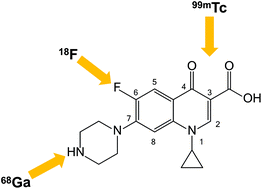当前位置:
X-MOL 学术
›
Dalton Trans.
›
论文详情
Our official English website, www.x-mol.net, welcomes your
feedback! (Note: you will need to create a separate account there.)
Fluoroquinolones as imaging agents for bacterial infection
Dalton Transactions ( IF 3.5 ) Pub Date : 2017-09-18 00:00:00 , DOI: 10.1039/c7dt01189j Syed Ali Raza Naqvi 1 , Karl Drlica
Dalton Transactions ( IF 3.5 ) Pub Date : 2017-09-18 00:00:00 , DOI: 10.1039/c7dt01189j Syed Ali Raza Naqvi 1 , Karl Drlica
Affiliation

|
Diagnosis of deep-seated bacterial infection is difficult, as neither standard anatomical imaging nor radiolabeled, autologous leukocytes distinguish sterile inflammation from infection. Two recent imaging efforts are receiving attention: (1) radioactive derivatives of sorbitol show good specificity with Gram-negative bacterial infections, and (2) success in combining anatomical and functional imaging for cancer diagnosis has rekindled interest in 99mTc-fluoroquinolone-based imaging. With the latter, computed tomography (CT) would be combined with single-photon-emission-computed tomography (SPECT) to detect 99mTc-fluoroquinolone-bacterial interactions. The present minireview provides a framework for advancing fluoroquinolone-based imaging by identifying gaps in our understanding of the process. One issue is the reliance of 99mTc labeling on the reduction of sodium pertechnetate, which can lead to colloid formation and loss of specificity. Specificity problems may be reduced by altering the quinolone structure (for example, switching from ciprofloxacin to sitafloxacin). Another issue is the uncharacterized nature of 99mTc-ciprofloxacin binding to, or sequestration in, bacteria: specific interactions with DNA gyrase, an intracellular fluoroquinolone target, are unlikely. Labeling with 68Ga rather than 99mTc enables detection by positron emission tomography, but with similar biological uncertainties. Replacing the C6-F of the fluoroquinolone with 18F provides an alternative to pertechnetate and gallium that may lead to imaging based on drug interactions with gyrase. Gyrase-based imaging requires knowledge of fluoroquinolone action, which we update. We conclude that quinolone-based probes show promise for the diagnosis of infection, but improvements in specificity and sensitivity are needed. These improvements include the optimization of the quinolone structure; such chemistry efforts can be accelerated by refining microbiological assays.
中文翻译:

氟喹诺酮类药物作为细菌感染显像剂
深层细菌感染的诊断很困难,因为标准解剖成像和放射性标记的自体白细胞都无法区分无菌炎症和感染。最近的两项成像工作正在受到关注:(1) 山梨醇的放射性衍生物对革兰氏阴性细菌感染表现出良好的特异性,(2) 结合解剖学和功能成像进行癌症诊断的成功重新点燃了人们对基于99m Tc-氟喹诺酮的成像的兴趣。对于后者,计算机断层扫描 (CT) 将与单光子发射计算机断层扫描 (SPECT) 相结合,以检测99m Tc-氟喹诺酮-细菌相互作用。本小型综述通过确定我们对该过程理解中的差距,为推进基于氟喹诺酮的成像提供了一个框架。一个问题是99m Tc 标记依赖于高锝酸钠的还原,这可能导致胶体形成和特异性丧失。通过改变喹诺酮结构(例如,从环丙沙星改为西他沙星)可以减少特异性问题。另一个问题是99m Tc-环丙沙星与细菌结合或隔离在细菌中的未表征的性质:不太可能与细胞内氟喹诺酮靶标 DNA 旋转酶发生特异性相互作用。用68 Ga 而不是99m Tc 标记可以通过正电子发射断层扫描进行检测,但具有类似的生物学不确定性。 用18 F 取代氟喹诺酮的 C6-F 提供了高锝酸盐和镓的替代品,可能导致基于药物与旋转酶相互作用的成像。基于旋转酶的成像需要了解氟喹诺酮作用的知识,我们对此进行了更新。我们的结论是,基于喹诺酮的探针有望用于感染诊断,但需要提高特异性和敏感性。这些改进包括喹诺酮结构的优化;通过改进微生物测定可以加速这种化学工作。
更新日期:2017-09-18
中文翻译:

氟喹诺酮类药物作为细菌感染显像剂
深层细菌感染的诊断很困难,因为标准解剖成像和放射性标记的自体白细胞都无法区分无菌炎症和感染。最近的两项成像工作正在受到关注:(1) 山梨醇的放射性衍生物对革兰氏阴性细菌感染表现出良好的特异性,(2) 结合解剖学和功能成像进行癌症诊断的成功重新点燃了人们对基于99m Tc-氟喹诺酮的成像的兴趣。对于后者,计算机断层扫描 (CT) 将与单光子发射计算机断层扫描 (SPECT) 相结合,以检测99m Tc-氟喹诺酮-细菌相互作用。本小型综述通过确定我们对该过程理解中的差距,为推进基于氟喹诺酮的成像提供了一个框架。一个问题是99m Tc 标记依赖于高锝酸钠的还原,这可能导致胶体形成和特异性丧失。通过改变喹诺酮结构(例如,从环丙沙星改为西他沙星)可以减少特异性问题。另一个问题是99m Tc-环丙沙星与细菌结合或隔离在细菌中的未表征的性质:不太可能与细胞内氟喹诺酮靶标 DNA 旋转酶发生特异性相互作用。用68 Ga 而不是99m Tc 标记可以通过正电子发射断层扫描进行检测,但具有类似的生物学不确定性。 用18 F 取代氟喹诺酮的 C6-F 提供了高锝酸盐和镓的替代品,可能导致基于药物与旋转酶相互作用的成像。基于旋转酶的成像需要了解氟喹诺酮作用的知识,我们对此进行了更新。我们的结论是,基于喹诺酮的探针有望用于感染诊断,但需要提高特异性和敏感性。这些改进包括喹诺酮结构的优化;通过改进微生物测定可以加速这种化学工作。











































 京公网安备 11010802027423号
京公网安备 11010802027423号